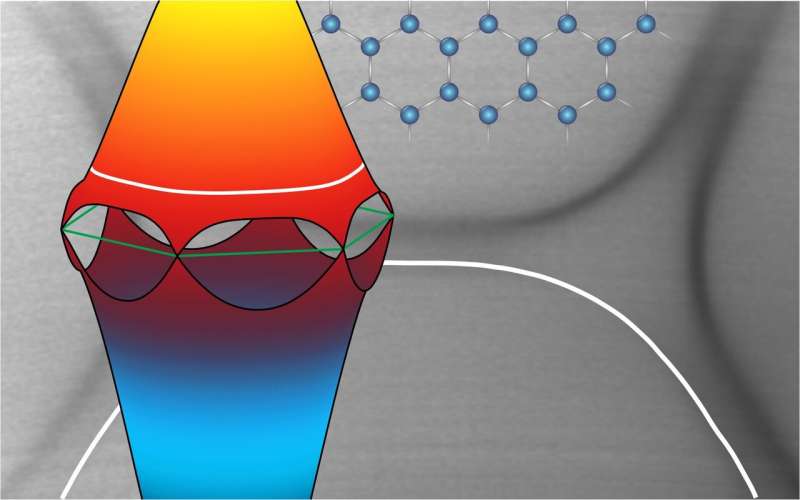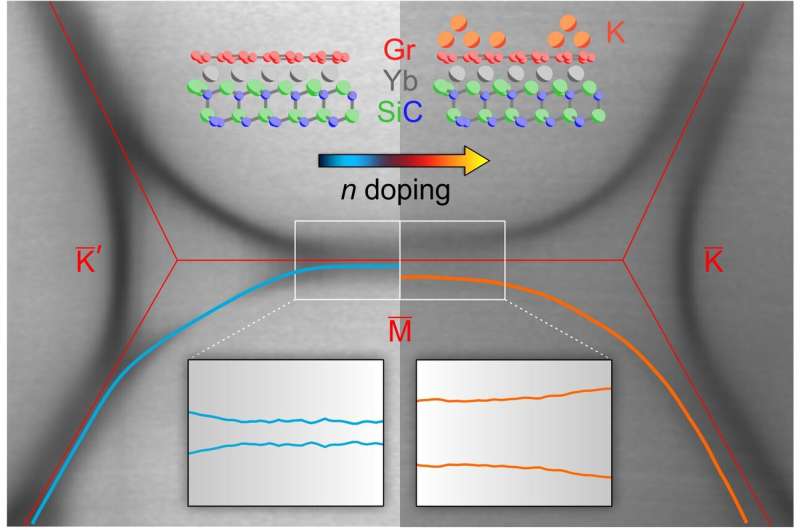For the first time, graphene is electron-doped past its van Hove singularity. Left: modelled energy levels of graphene with exemplary Fermi level (white curve) beyond the singularity. Background: experimental Fermi surface of overdoped graphene. Credit: Max Planck Institute for Solid State Research / Rosenzweig et al.
For over a decade, theoretical physicists have predicted that the van Hove singularity of graphene could be associated with different exotic phases of matter, the most notable of which is chiral superconductivity.
A van Hove singularity is essentially a non-smooth point in the density of states (DOS) of a crystalline solid. When graphene reaches or is close to this specific energy level, a flat band develops in its electronic structure that can occupy an exceptionally large number of electrons. This leads to strong many-body interactions that promote or enable the existence of exotic states of matter.
So far, the exact degree to which the available energy levels of graphene need to be filled with electrons (i.e., "doped") in order for individual phases to stabilize has been very difficult to determine using model calculations. Identifying or designing techniques that can be used to dope graphene to or beyond the van Hove singularity could ultimately lead to interesting observations related to exotic phases of matter, which could in turn pave the way towards the development of new graphene-based technology.
Researchers at the Max Planck Institute for Solid State Research in Stuttgart, Germany have recently devised an approach to over-dope graphene beyond the van Hove singularity. Their method, presented in a paper published in Physical Review Letters, combines two different techniques, namely ytterbium intercalation and potassium adsorption.
"An experimentally tunable electron density in the vicinity of the van Hove singularity would be highly desirable," Philipp Rosenzweig, one of the researchers who carried out the study, told Phys.org. "Earlier experiments demonstrated that graphene can indeed be stabilized ('pinned') at the van Hove level and that charge carriers can subsequently be removed from this pinning scenario. The question we asked, however, is can we also transfer more electrons onto the graphene layer, overcome the van Hove pinning and over-dope beyond the singularity? Apart from the pure proof of principle, this would open up an unexplored playground of correlated phases with exciting promises."
Doping graphene to the van Hove singularity is a challenging task in itself, as it requires the transfer of over 100 trillion (1014) electrons per cm2 onto the graphene layer. The doping of graphene can be achieved by depositing other atomic species on top of it, which donate some of their electrons to it.
An alternative method for doping graphene, known as intercalation, entails sandwiching doping agents between graphene and its supporting substrate. Over the past decade, this technique has proved to be highly useful for tuning the electronic properties of the material.
Via deposition of potassium (K) - an electron donor - on top of graphene pre-intercalated with Ytterbium (Yb), the system is eventually forced beyond its van Hove singularity. Upon overdoping the giant Fermi surface contours split off from each other. Credit: Max Planck Institute for Solid State Research / Rosenzweig et al.
Typically, even when deposition and intercalation approaches are combined, the carrier density of graphene is difficult to increase to an arbitrary value. This is primarily because the charge transfer will eventually saturate, preventing it from being doped above a certain level.
"Recently, we discovered that the intercalation of certain rare-earth elements, due to their huge doping efficiency, is already sufficient to pin graphene at its van Hove singularity," Rosenzweig said. "In that case, the surface of graphene still remains free to occupy additional dopants. Starting from the van Hove scenario of ytterbium-intercalated graphene, by depositing potassium atoms on top, we were thus able to increase the carrier density by another factor of 1.5, going well beyond the singularity level."
In their experiments, the researchers used ytterbium intercalation and potassium adsorption methods. This approach allowed them to dope a layer of graphene placed on a semiconducting silicon carbide (SiC) substrate beyond the van Hove singularity, reaching a charge carrier density of 5.5 x 1014 cm-2.
"You could compare the strategy we used to a situation in daily life where a bulky object needs to be carried up the stairs to the top floor (in our case, beyond the van Hove singularity)," Rosenzweig explained. "This might only become possible by simultaneously pushing from below (i.e., ytterbium intercalation) and pulling from the top (i.e., potassium adsorption)."
The study carried out by Rosenzweig and his colleagues proves that doping graphene beyond its van Hove singularity in an experimental setting is in fact possible. The researchers examined their graphene system using a technique called angle-resolved photoelectron spectroscopy, in tests performed at the BESSY II synchrotron, Helmholtz-Zentrum Berlin. This method enables the direct visualization of the energy band structure of graphene and its evolution through doping.
"The feasibility of over-doping was previously far from clear, as the system is first pinned to the singularity level occupying a huge number of charge carriers," Rosenzweig said. "Practically, by pushing the doping of graphene to new levels, our study also opens up a new and unexplored landscape in the phase diagram of this prototype two-dimensional material. As such, we hope that our work will contribute to reinforcing the quest for correlated ground states in monolayer graphene which would definitely be of interest across various subfields in physics."
In the future, the findings gathered by Rosenzweig and his colleagues could open up new exciting possibilities for the study of exotic states of matter in graphene that is doped beyond its van Hove singularity. Moreover, this recent study could enhance the current understanding of the strong nonlocal many-body interactions in van Hove-doped graphene that have been found to have substantial warping effects on its energy levels. The researchers demonstrated that such effects are still present in the over-doped regime and that they become increasingly as graphene approaches the van Hove singularity. The data they gathered could thus also inspire the development of new theoretical models that reach beyond conventional Fermi liquid theory.
"Now that we can routinely tune the doping level in experiments around the van Hove level, we are looking for any of the various exotic phases predicted by theory," Rosenzweig concluded. "To shoot for the stars, realizing unconventional superconductivity in an epitaxial graphene monolayer would of course be a groundbreaking discovery that might one day lead to technological applications. In any case, exciting times are ahead for van-Hove doped graphene."
More information: Philipp Rosenzweig et al. Overdoping Graphene Beyond the van Hove Singularity, Physical Review Letters (2020). DOI: 10.1103/PhysRevLett.125.176403
Journal information: Physical Review Letters
© 2020 Science X Network

























